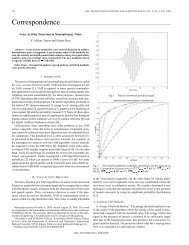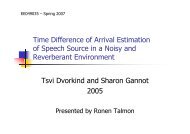Thesis (PDF) - Signal & Image Processing Lab
Thesis (PDF) - Signal & Image Processing Lab
Thesis (PDF) - Signal & Image Processing Lab
You also want an ePaper? Increase the reach of your titles
YUMPU automatically turns print PDFs into web optimized ePapers that Google loves.
6.1. EXTREMA WATERSHED TREE DESCRIPTION 77<br />
its label; GL(V ) is the gray level of region corresponding to V ; F ather(V ) is the<br />
father vertex of V in the tree; and Size(V ) is the number of pixels in V . An exact<br />
comparison function is shown in Algorithm 2 below.<br />
In every algorithm cycle, the smallest edge is removed from the edges queue and<br />
merged to create a new flat zone. In the merge process, a newly created flat zone<br />
receives a gray level of an edge vertex other than extremum and is derived by a region<br />
that is a union of both components. Then, all neighbor edges are extracted from the<br />
queue and new edges with a new vertex are added only if they still include extremum<br />
vertices. A pseudo code of the algorithm we developed is listed in Algorithm 3 below.<br />
Using notions of merging order, merging criterion and region model in-<br />
troduced in [23], the proposed representation has a merging order according to a<br />
queue sorted by an order function shown in algorithm 2. Its merging criterion is<br />
whether the edge in question is the first in the queue of all edges. And the region<br />
model as described in the algorithm, is to take a gray level of the vertex other than<br />
the extremum and use a union of their regions.<br />
This algorithm resembles an algorithm introduced by Vachier and Vincent in<br />
[24]. One difference is in the merging order: our main merge criteria is the size of<br />
an extremum, which is not the case in Vachier and Vincent’s algorithm. Another<br />
difference is that the resulting tree is used here to define morphological operators,<br />
whereas Vachier and Vincent use it as an intermediate step for computing symmetrical<br />
dynamics (see [24] for details).<br />
Let’s take a 1-dimensional example to illustrate the tree structure. Figure 6.2<br />
shows the first 3 steps in creating the extrema watershed tree. A source image includes<br />
2 flat zones with extremum gray levels - v3 and v5. The first step in the algorithm is<br />
to merge v3 and v2, because v3 is a small extremum (only 1 point) and because it’s<br />
gray level is closer to v2 then v5 with v6. The merge creates a new flat zone - v7 with<br />
gray level 9. A gray level is taken from a flat zone other than the extremum. The<br />
region of a new flat zone is a merge of the two source regions. The newly created v7<br />
is a new extremum in the image. In the next step another extremum - v5 is merged<br />
with v6 to create v8, because v5 is the smallest extremum in the image. In the third<br />
step v7 is merged with v4 to create v9. At that stage all remaining flat zones are<br />
extremum. The next merge steps are to merge v8 and v9 with v10 and finally v10 is<br />
merged with v1 a root. The choice between merging of v8 with v9 or v1 with v9 is
















